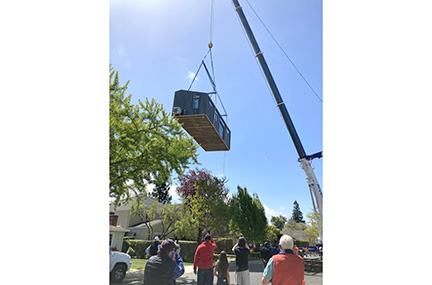
This story was originally appeared in the July 2 print edition of the Daily Post. If you don’t want to miss out on important local news, pick up the Post in the mornings at 1,000 Mid-Peninsula locations.
BY ELAINE GOODMAN
Daily Post Correspondent
Palo Alto’s Planning and Transportation Commission has voted against several proposed incentives intended to encourage homeowners to build granny units and then rent them at affordable rates.
The commission on June 30 gave a thumbs down to a proposal that would allow a single-family home owner to build two granny units on their property, rather than one as is currently allowed, if one of the two units was an affordable rental.
In addition, the commission voted against allowing a granny unit to be as large as 1,200 square feet — up from the city’s current limit of 1,000 square feet — if the unit is offered as an affordable rental. Granny units are also known as accessory dwelling units, or ADUs.
Commission members also opposed a proposed incentive that would allow an affordable granny unit to be less than four feet away from a neighbor’s property. The idea is that the reduced setback would leave the homeowner with some additional space after the affordable ADU is built.
An incentive that the commission did endorse is for the city to waive development impact fees for affordable granny units. The city now waives those fees for ADUs that are smaller than 750 square feet.
The commission’s votes serve as recommendations. Before an affordable ADU incentive is finalized, it would be written into a draft ordinance that would go to the City Council for final approval.
A single-family lot in Palo Alto can currently contain up to three units: the main home, a granny unit and a junior ADU. Junior ADUs, or JADUs, are units of up to 500 square feet attached to the main home. A regular ADU can be attached to the home or detached.
With the proposed incentive to grant a bonus ADU to a homeowner who provides an affordable rental, a property could in theory have four units: the main home, a junior ADU, an ADU and an affordable ADU, according to the report to the planning commission. The affordable unit could be either an ADU or a junior ADU.
But commission members had concerns about allowing an extra unit.
“I worry about the parking. I worry about the loss of backyard habitat for flora and fauna,” said commission member Doria Summa. “I also worry that this would be attractive mostly to investors that aren’t really a part of the community but would like to maximize profit in a place they don’t live in.”
Commission Chairman Bart Hechtman said that few single-family lots in Palo Alto would have enough space for four units. That reduces the value of the incentive, he said, while creating concern in the community.
“We’re going to have a lot of people unnecessarily worried,” Hechtman said.
The proposed incentives would be a trade-off for the homeowner agreeing to deed-restrict the ADU to being affordable. A prospective tenant would go through an income verification process to see if they qualify to rent the ADU.
Commission members had mixed views on whether to allow an ADU to be as large as 1,200 square feet as an incentive for an affordable unit. The city now allows a two-bedroom ADU to be up to 1,000 square feet.
Hechtman said with the extra 200 square feet, a homeowner could build a three-bedroom unit. The homeowner would be able to get more for renting a three-bedroom versus a two-bedroom ADU, especially after the deed restriction expires, he said.
But commissioner Carolyn Templeton said that in some neighborhoods, a 1,200-square-foot ADU would be larger than the main house. She cautioned against creating a “de facto R2 zone instead of actually zoning it that way.”
The commission also rejected a proposed incentive in which basement areas of an affordable ADU wouldn’t count toward square footage limits. Some pointed to the environmental impacts of building basements, while others said it’s unlikely that a homeowner would use such an expensive building technique for a unit that would be rented at affordable rates.
Commission members supported an affordable-ADU incentive related to garages, saying that they wished the change would apply to all ADUs.
Under the city’s existing rules, a homeowner can convert a garage to an ADU without the need to replace the lost parking. At the same time, the city requires a new home to have one covered and one uncovered parking space.
That means someone who wants to build a new home with an ADU often must go through a two-step process: Build the home with a garage, and then convert the garage to an ADU. The proposed incentive would allow someone to build a new home with an affordable ADU, without building a garage first.


